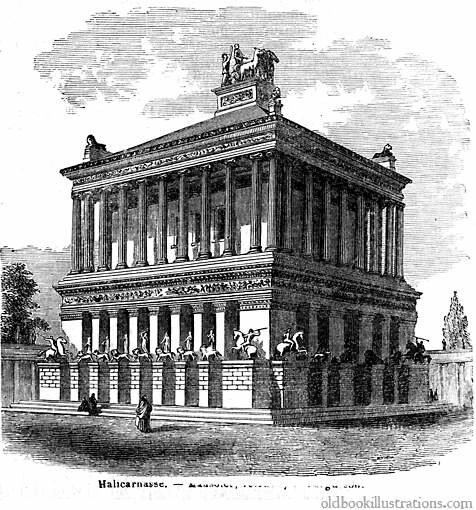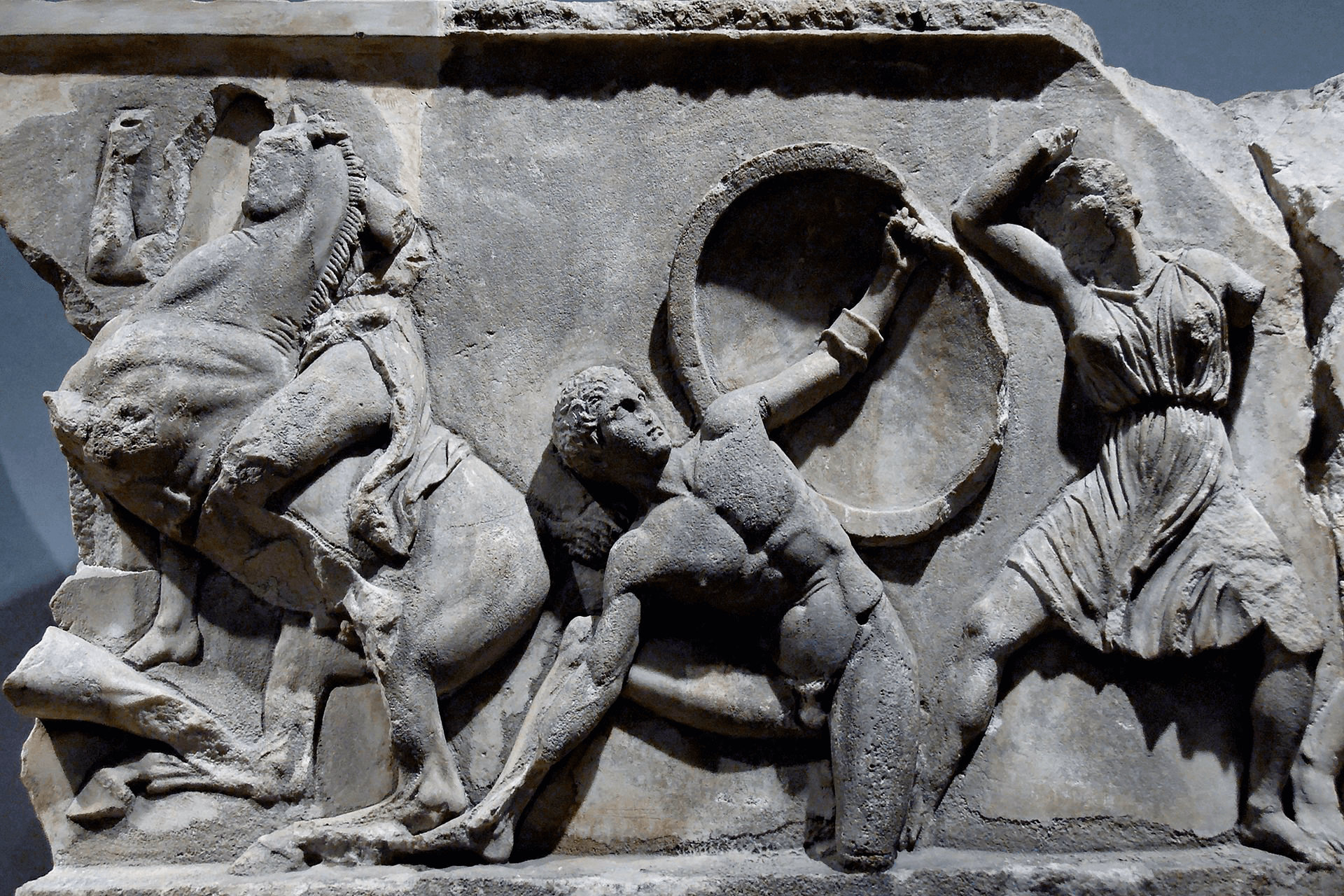Settlements > Halicarnassus
Halicarnassus
Background
Halicarnassus was an ancient Greek city that is located in modern day Turkey. The city is famous for featuring the Mausoleum at Halicarnassus (353-350 BCE) which was one of the fabled Wonders of the Ancient World at the time.
The city was eventually captured by the Persian Achaemenid Empire where it remained until it was recaptured for the Greeks by Alexander III the Great during his campaign in 334 BCE.

Mausoleum at Halicarnassus - Martin Heemskerck (1572)
Origins
The first Halicarnassus was built on a small island off the shore called Zephyria. It appears to have been a Dorian colony whose settlers may have come from Troezen or Argos based on the gods they worshiped. Currently on the original site of Halicarnassus sits the Castle of St. Peter that was built by the Knights of Rhodes in 1404. The island was eventually united with the mainland overtime and the city grew to encompass a much larger territory.
The first settlers of Halicarnassus had coins that featured famous Greek characters such as Medusa, Athena and Poseidon, along with a motif of the trident. This indicates they were from the cities of Troezen or Argos. The city existed under these rulers for a period of time until Artemisia I of Caria became its defacto ruler.
Artemisia I of Caria
Artemisia I of Caria is most famous for being involved in the Battle of Salamis. She was able to pass down rule over Halicarnassus to her son Pisindalis of which very little is known. Pisindalis was succeeded in power by Lygdamis who was responsible for the execution of the poet Panyasis and caused the famous historian Herodotus to flee his home city in 457 BCE.
Hekatomnid Dynasty
Hecatomnus became king of Caria, at that time part of the Persian Empire, ruling from 404 BC to 358 BC and establishing the Hekatomnid dynasty. He left three sons, Mausolus, Idrieus and Pixodarus – all of whom – in their turn, succeeded him in the sovereignty; and two daughters, Artemisia and Ada, who were married to their brothers Mausolus and Idrieus.
Mausolus moved his capital from Mylasa to Halicarnassus. His workmen deepened the city's harbor and used the dragged sand to make protecting breakwaters in front of the channel[citation needed]. On land they paved streets and squares, and built houses for ordinary citizens. And on one side of the harbor they built a massive fortified palace for Mausolus, positioned to have clear views out to sea and inland to the hills — places from where enemies could attack. On land, the workmen also built walls and watchtowers, a Greek–style theatre and a temple to Ares — the Greek god of war.

Mausoleum at Halicarnassus - Trousset Encyclopedia (1886–1891)
Artemisia and Mausolus spent huge amounts of tax money to embellish the city. They commissioned statues, temples and buildings of gleaming marble. When he died in 353 BC, his wife, sister and successor, Artemisia II of Caria, began construction of a magnificent tomb for him and herself on a hill overlooking the city. She died in 351 BC (of grief, according to Cicero; Tusculan Disputations 3.31). According to Pliny the Elder the craftsmen continued to work on the tomb after the death of their patron, "considering that it was at once a memorial of his own fame and of the sculptor's art," finishing it in 350 BC. This tomb of Mausolus came to be known as the Mausoleum, one of the seven wonders of the ancient world.
Artemisia was succeeded by her brother Idrieus, who, in turn, was succeeded by his wife and sister Ada when he died in 344 BC. However, Ada was usurped by her brother Pixodarus in 340 BC. On the death of Pixodarus in 335 BC his son-in-law, a Persian named Orontobates, received the satrapy of Caria from Darius III of Persia.
Alexander the Great
Halicarnassus was an important stop along Alexander III the Great's journey through the ancient world. When he entered the territory of Caria in 334 BCE, Halicarnassus was ruled by Ada of Caria. She surrendered the fortress of Alinda to him and as a reward he handed back control of Halicarnassus to Ada.

Halicarnassus Wall Relief
In return for letting her govern Halicarnassus, Ada formally adopted Alexander as her son. This ensured that upon her death rule would pass without contest to Alexander and he would cement his rule as King of the region.
Siege of Halicarnassus
Sources
- Abila
- Adramyttion
- Ahsiket
- Akanthos
- Aleppo
- Alexandria Ad Issum
- Alexandria Arachosia
- Alexandria Ariana
- Alexandria Asiana
- Alexandria Bucephalous
- Alexandria By The Latmus
- Alexandria Eschate
- Alexandria In Carmania
- Alexandria In Egypt
- Alexandria In Makarene
- Alexandria In Margiana
- Alexandria In Opiana
- Alexandria In Orietai
- Alexandria In Susiana
- Alexandria Near Issus
- Alexandria Niceae
- Alexandria On The Caucasus
- Alexandria On The Hyphasis
- Alexandria On The Indus
- Alexandria On The Oxus
- Alexandria Prophthasia
- Alexandria Rhambacia
- Alexandria Tarmita
- Alexandria Troas
- Alexandria
- Alexandrian Settlements
- Alexandrupolis
- Alinda
- Amaseia
- Amorium
- Amphipolis
- Amyzon
- Anatolian Settlements
- Ancoz
- Anthemusias
- Antigonia Chaonia
- Antigonia In Paeonia
- Antigonia In Syria
- Antigonia Psaphara
- Antigonid Settlements
- Antioch Epidaphne
- Antioch Of Hippos
- Antioch Of Pisidia
- Antioch On The Golden River
- Antioch On The Maeander
- Antioch On The Orontes
- Antioch
- Antiochia Ad Cragum
- Antiochia Ad Pyramum
- Antiochia Ad Taurum
- Antiochia In Cilicia
- Antiochia In Lydia
- Antiochia In Mesopotamia
- Antiochia In Scythia
- Antiochia In Sittacene
- Antiochia In Susiana
- Antiochia Lamotis
- Antiochia Mygdonia
- Antiochia Of Chosroes
- Antiochia Of The Chrysaorians
- Antiochia On The Callirhoe
- Antiochia On The Cydnus
- Antiochia On The Taurus
- Antiochia Paraliou
- Antipatrid Settlements
- Apamea Cibotus
- Apamea In Babylonia
- Apamea In Media
- Apamea In Sittacene
- Apamea In Syria
- Apamea Myrlea
- Apamea On The Euphrates
- Apamea Ragiana
- Apollonia
- Arbela
- Aretas IV Philopatris
- Arg E Bam
- Argead Settlements
- Argos
- Arigaeum
- Arsameia
- Arsamosata
- Arsinoe Epidires
- Arsinoe In Cilicia
- Arsinoe In Crete
- Arsinoe In Northwest Cyprus
- Arsinoe In Southwest Cyprus
- Arsinoites
- Artemita In Apolloniatis
- Ashkelon
- Asian Settlements
- Astacus In Bithynia
- Aswan
- Asyut
- Athens
- Attalea
- Attalid Settlements
- Ay Khanum
- Baalbek
- Babylon
- Bactra
- Bactrian Settlements
- Balasagun
- Barbarikon
- Bellegrada
- Berenice Epideires
- Berenice Panchrysos
- Berenice Troglodytica
- Berenike
- Birtha
- Bithynian Settlements
- Blaundos
- Bolbitine
- Borsippa
- Buto
- Byblos
- Byzantium
- Canopus
- Carian Settlements
- Carthage
- Cassandreia
- Cebrene
- Chalcedon
- Cius
- Corinth
- Corycus
- Ctesiphon
- Cyrene
- Cyropolis
- Cyrrhus
- Cyzicus
- Dalverzin Tepe
- Damascus
- Daphne
- Dascylium
- Dathema
- Decapolis
- Delos
- Delphi
- Demetriapolis
- Demetrias In Assyria
- Demetrias
- Diadochoupolis
- Dion
- Docimium
- Dumatha
- Ecbatana
- Edessa
- Egyptian Settlements
- Ekron
- Elaea Lebanon
- Elaea
- Emirzeli
- Ephesus
- Epirote Settlements
- Eshnunna
- Eucratideia
- European Settlements
- Gabai
- Gamla
- Gath
- Gaza
- Gazoros
- Gerrha
- Giza
- Gordium
- Greek Settlements
- Halicarnassus
- Harran
- Hegra
- Hekatompylos
- Heliopolis
- Hellenistic Colonies
- Hellenopolis
- Heraclea Lyncestis
- Heraclea Pontica
- Heraclea Sintica
- Heraclea
- Hierapolis
- Ikaros
- Indian Settlements
- Indo Greek Settlements
- Issus
- Jerusalem
- Kale Krsevica
- Kalindoia
- Kandyba
- Knidos
- Komopolis
- Konope
- Kos
- Lagina
- Lamia
- Lampsacus
- Laodicea Ad Libanum
- Laodicea Combusta
- Laodicea Pontica
- Laodicea
- Laodiceia
- Leuke Kome
- Lysimachia
- Lysimachian Settlements
- Macedonian Settlements
- Magnesia Ad Sipylum
- Maracanda
- Marathon
- Mathura
- Mediterranean Settlements
- Megara Hyblaea
- Megara
- Memphis
- Merv
- Mesopotamian Settlements
- Metropolis
- Milas
- Miletus
- Myos Hormos
- Myra
- Mysomakedones
- Negotino
- Nicaea And Bucephala
- Nicaea
- Niya
- Nysa On The Maeander
- Olympia
- Olympos
- Olynthus
- Ouranoupoli
- Palmyra
- Paneas
- Paroecopolis
- Pasargadae
- Patala
- Pataliputra
- Pelium
- Pella
- Pelusium
- Pentapolis
- Pergamon
- Perseis
- Persepolis
- Persian Settlements
- Petra
- Peucela
- Phasaelis
- Phaselis
- Phila
- Philadelphia
- Philippopolis
- Phoenician Settlements
- Phthiotic Thebes
- Plataea
- Prophthasia In Drangiana
- Prusa
- Pteria
- Ptolemaic Settlements
- Ptolemais Hermiou
- Ptolemais Theron
- Ptolemais
- Pythion
- Qalatga Darband
- Raphia
- Rhacotis
- Rhambacia
- Rhinocorura
- Rhodes
- Rome
- Sagala
- Sagalassos
- Saketa
- Saksanokhur
- Samosata
- Sardis
- Seleucia Ad Belum
- Seleucia At The Zeugma
- Seleucia In Sittacene
- Seleucia On The Calycadnus
- Seleucia On The Hedyphon
- Seleucia On Tigris
- Seleucia Pamphylia
- Seleucia Pieria
- Seleucia Samulias
- Seleucia Sidera
- Seleucia
- Seleucid Settlements
- Serraepolis
- Sialkot
- Side
- Sidon
- Sirkap
- Siwa Oasis
- Smyrna
- Soli
- Sparta
- Stratonicea In Caria
- Stratonicea In Lydia
- Stratonicea
- Sulusaray
- Susa
- Syracuse
- Syrian Tetropolis
- Taposiris Magna
- Tarsus
- Taxila
- Tel Anafa
- Termessos
- Thapsacus
- Tharros
- Thebes Egypt
- Thebes Greece
- Therma
- Thermos
- Thessaloniki
- Thmuis
- Troy
- Tyre
- Uranopolis
- Xanthos
- Yerevan
- Zeugma